A Detailed Analysis: Basel III, Financial Crisis, and Banking Sector
VerifiedAdded on 2020/12/09
|8
|2481
|327
Report
AI Summary
This report examines the implementation of Basel III and its effects on the banking sector, particularly in the context of the 2007-09 financial crisis. It includes a literature review of Basel III, discussing its three pillars and the importance of capital and liquidity ratios. The report analyzes the impact of the financial crisis on the Bank of England and Barclay Bank, focusing on various risks such as liquidity, credit, and interest rate risks. It highlights the challenges faced by banks and the measures taken to mitigate these risks, including the role of the Bank of England in maintaining financial stability and addressing the economic recession. The analysis underscores the importance of Basel III in enhancing risk management, capital adequacy, and overall stability within the banking system.

MONEY AND BANKING
Paraphrase This Document
Need a fresh take? Get an instant paraphrase of this document with our AI Paraphraser
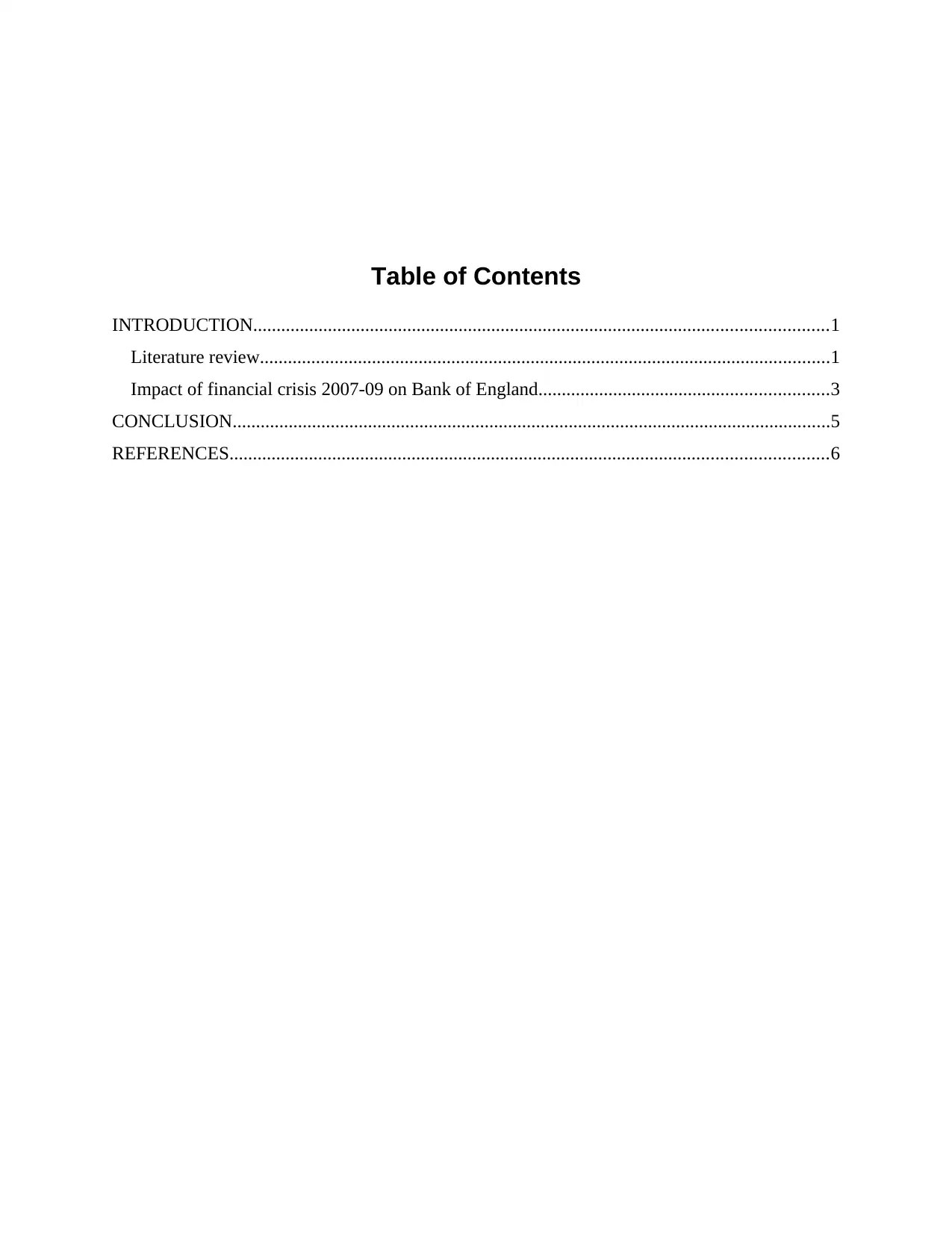
Table of Contents
INTRODUCTION...........................................................................................................................1
Literature review..........................................................................................................................1
Impact of financial crisis 2007-09 on Bank of England..............................................................3
CONCLUSION................................................................................................................................5
REFERENCES................................................................................................................................6
INTRODUCTION...........................................................................................................................1
Literature review..........................................................................................................................1
Impact of financial crisis 2007-09 on Bank of England..............................................................3
CONCLUSION................................................................................................................................5
REFERENCES................................................................................................................................6
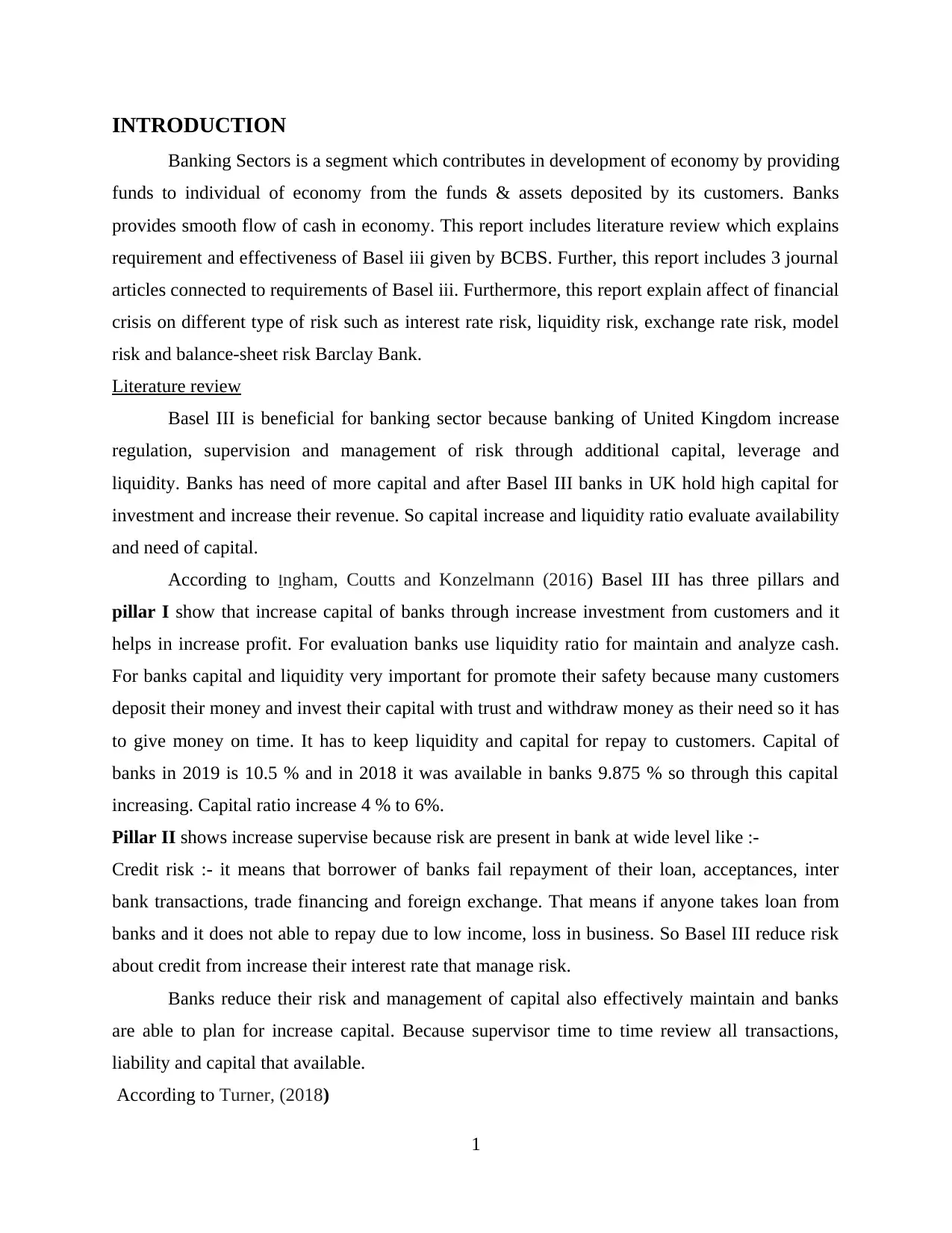
INTRODUCTION
Banking Sectors is a segment which contributes in development of economy by providing
funds to individual of economy from the funds & assets deposited by its customers. Banks
provides smooth flow of cash in economy. This report includes literature review which explains
requirement and effectiveness of Basel iii given by BCBS. Further, this report includes 3 journal
articles connected to requirements of Basel iii. Furthermore, this report explain affect of financial
crisis on different type of risk such as interest rate risk, liquidity risk, exchange rate risk, model
risk and balance-sheet risk Barclay Bank.
Literature review
Basel III is beneficial for banking sector because banking of United Kingdom increase
regulation, supervision and management of risk through additional capital, leverage and
liquidity. Banks has need of more capital and after Basel III banks in UK hold high capital for
investment and increase their revenue. So capital increase and liquidity ratio evaluate availability
and need of capital.
According to Ingham, Coutts and Konzelmann (2016) Basel III has three pillars and
pillar I show that increase capital of banks through increase investment from customers and it
helps in increase profit. For evaluation banks use liquidity ratio for maintain and analyze cash.
For banks capital and liquidity very important for promote their safety because many customers
deposit their money and invest their capital with trust and withdraw money as their need so it has
to give money on time. It has to keep liquidity and capital for repay to customers. Capital of
banks in 2019 is 10.5 % and in 2018 it was available in banks 9.875 % so through this capital
increasing. Capital ratio increase 4 % to 6%.
Pillar II shows increase supervise because risk are present in bank at wide level like :-
Credit risk :- it means that borrower of banks fail repayment of their loan, acceptances, inter
bank transactions, trade financing and foreign exchange. That means if anyone takes loan from
banks and it does not able to repay due to low income, loss in business. So Basel III reduce risk
about credit from increase their interest rate that manage risk.
Banks reduce their risk and management of capital also effectively maintain and banks
are able to plan for increase capital. Because supervisor time to time review all transactions,
liability and capital that available.
According to Turner, (2018)
1
Banking Sectors is a segment which contributes in development of economy by providing
funds to individual of economy from the funds & assets deposited by its customers. Banks
provides smooth flow of cash in economy. This report includes literature review which explains
requirement and effectiveness of Basel iii given by BCBS. Further, this report includes 3 journal
articles connected to requirements of Basel iii. Furthermore, this report explain affect of financial
crisis on different type of risk such as interest rate risk, liquidity risk, exchange rate risk, model
risk and balance-sheet risk Barclay Bank.
Literature review
Basel III is beneficial for banking sector because banking of United Kingdom increase
regulation, supervision and management of risk through additional capital, leverage and
liquidity. Banks has need of more capital and after Basel III banks in UK hold high capital for
investment and increase their revenue. So capital increase and liquidity ratio evaluate availability
and need of capital.
According to Ingham, Coutts and Konzelmann (2016) Basel III has three pillars and
pillar I show that increase capital of banks through increase investment from customers and it
helps in increase profit. For evaluation banks use liquidity ratio for maintain and analyze cash.
For banks capital and liquidity very important for promote their safety because many customers
deposit their money and invest their capital with trust and withdraw money as their need so it has
to give money on time. It has to keep liquidity and capital for repay to customers. Capital of
banks in 2019 is 10.5 % and in 2018 it was available in banks 9.875 % so through this capital
increasing. Capital ratio increase 4 % to 6%.
Pillar II shows increase supervise because risk are present in bank at wide level like :-
Credit risk :- it means that borrower of banks fail repayment of their loan, acceptances, inter
bank transactions, trade financing and foreign exchange. That means if anyone takes loan from
banks and it does not able to repay due to low income, loss in business. So Basel III reduce risk
about credit from increase their interest rate that manage risk.
Banks reduce their risk and management of capital also effectively maintain and banks
are able to plan for increase capital. Because supervisor time to time review all transactions,
liability and capital that available.
According to Turner, (2018)
1
⊘ This is a preview!⊘
Do you want full access?
Subscribe today to unlock all pages.

Trusted by 1+ million students worldwide
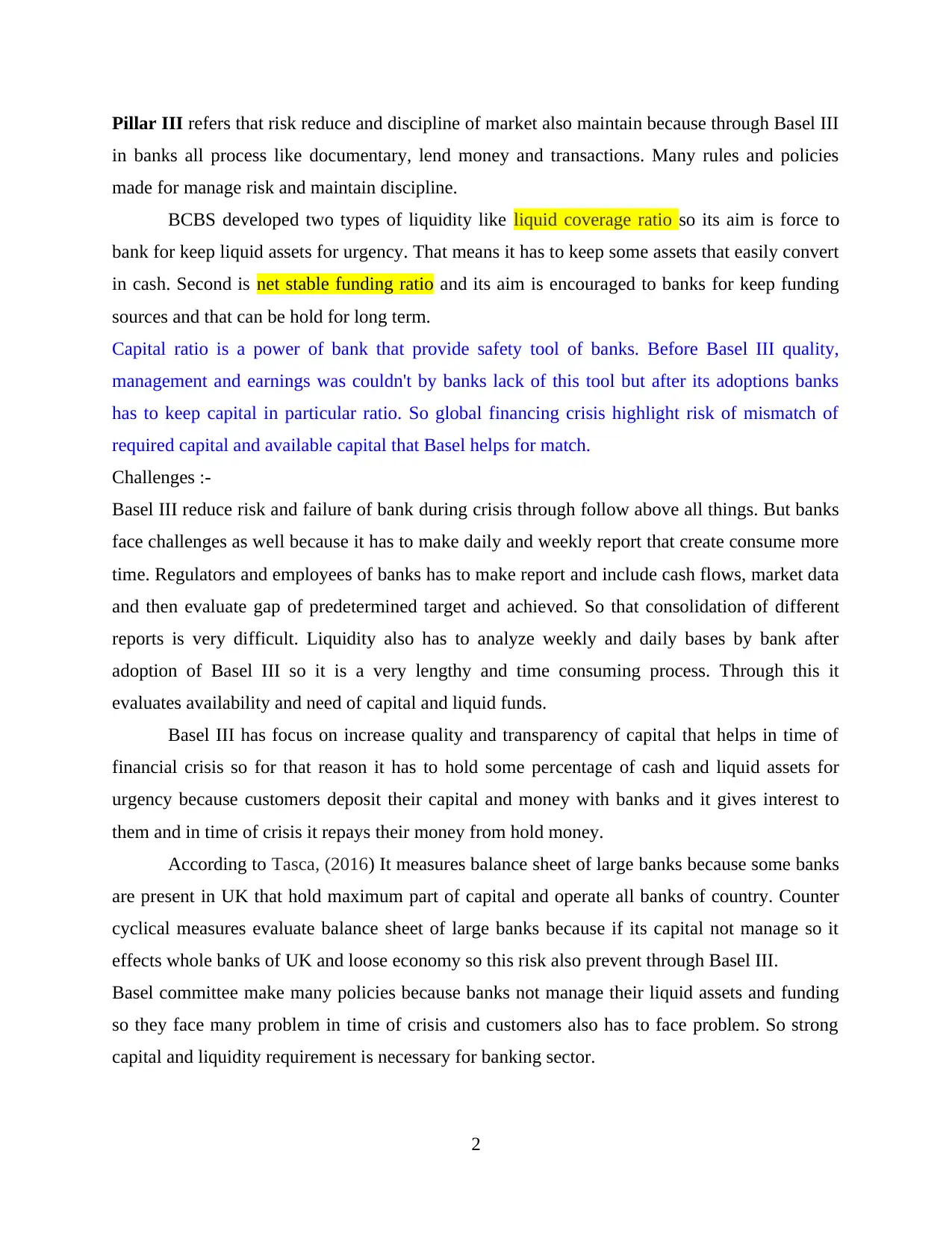
Pillar III refers that risk reduce and discipline of market also maintain because through Basel III
in banks all process like documentary, lend money and transactions. Many rules and policies
made for manage risk and maintain discipline.
BCBS developed two types of liquidity like liquid coverage ratio so its aim is force to
bank for keep liquid assets for urgency. That means it has to keep some assets that easily convert
in cash. Second is net stable funding ratio and its aim is encouraged to banks for keep funding
sources and that can be hold for long term.
Capital ratio is a power of bank that provide safety tool of banks. Before Basel III quality,
management and earnings was couldn't by banks lack of this tool but after its adoptions banks
has to keep capital in particular ratio. So global financing crisis highlight risk of mismatch of
required capital and available capital that Basel helps for match.
Challenges :-
Basel III reduce risk and failure of bank during crisis through follow above all things. But banks
face challenges as well because it has to make daily and weekly report that create consume more
time. Regulators and employees of banks has to make report and include cash flows, market data
and then evaluate gap of predetermined target and achieved. So that consolidation of different
reports is very difficult. Liquidity also has to analyze weekly and daily bases by bank after
adoption of Basel III so it is a very lengthy and time consuming process. Through this it
evaluates availability and need of capital and liquid funds.
Basel III has focus on increase quality and transparency of capital that helps in time of
financial crisis so for that reason it has to hold some percentage of cash and liquid assets for
urgency because customers deposit their capital and money with banks and it gives interest to
them and in time of crisis it repays their money from hold money.
According to Tasca, (2016) It measures balance sheet of large banks because some banks
are present in UK that hold maximum part of capital and operate all banks of country. Counter
cyclical measures evaluate balance sheet of large banks because if its capital not manage so it
effects whole banks of UK and loose economy so this risk also prevent through Basel III.
Basel committee make many policies because banks not manage their liquid assets and funding
so they face many problem in time of crisis and customers also has to face problem. So strong
capital and liquidity requirement is necessary for banking sector.
2
in banks all process like documentary, lend money and transactions. Many rules and policies
made for manage risk and maintain discipline.
BCBS developed two types of liquidity like liquid coverage ratio so its aim is force to
bank for keep liquid assets for urgency. That means it has to keep some assets that easily convert
in cash. Second is net stable funding ratio and its aim is encouraged to banks for keep funding
sources and that can be hold for long term.
Capital ratio is a power of bank that provide safety tool of banks. Before Basel III quality,
management and earnings was couldn't by banks lack of this tool but after its adoptions banks
has to keep capital in particular ratio. So global financing crisis highlight risk of mismatch of
required capital and available capital that Basel helps for match.
Challenges :-
Basel III reduce risk and failure of bank during crisis through follow above all things. But banks
face challenges as well because it has to make daily and weekly report that create consume more
time. Regulators and employees of banks has to make report and include cash flows, market data
and then evaluate gap of predetermined target and achieved. So that consolidation of different
reports is very difficult. Liquidity also has to analyze weekly and daily bases by bank after
adoption of Basel III so it is a very lengthy and time consuming process. Through this it
evaluates availability and need of capital and liquid funds.
Basel III has focus on increase quality and transparency of capital that helps in time of
financial crisis so for that reason it has to hold some percentage of cash and liquid assets for
urgency because customers deposit their capital and money with banks and it gives interest to
them and in time of crisis it repays their money from hold money.
According to Tasca, (2016) It measures balance sheet of large banks because some banks
are present in UK that hold maximum part of capital and operate all banks of country. Counter
cyclical measures evaluate balance sheet of large banks because if its capital not manage so it
effects whole banks of UK and loose economy so this risk also prevent through Basel III.
Basel committee make many policies because banks not manage their liquid assets and funding
so they face many problem in time of crisis and customers also has to face problem. So strong
capital and liquidity requirement is necessary for banking sector.
2
Paraphrase This Document
Need a fresh take? Get an instant paraphrase of this document with our AI Paraphraser
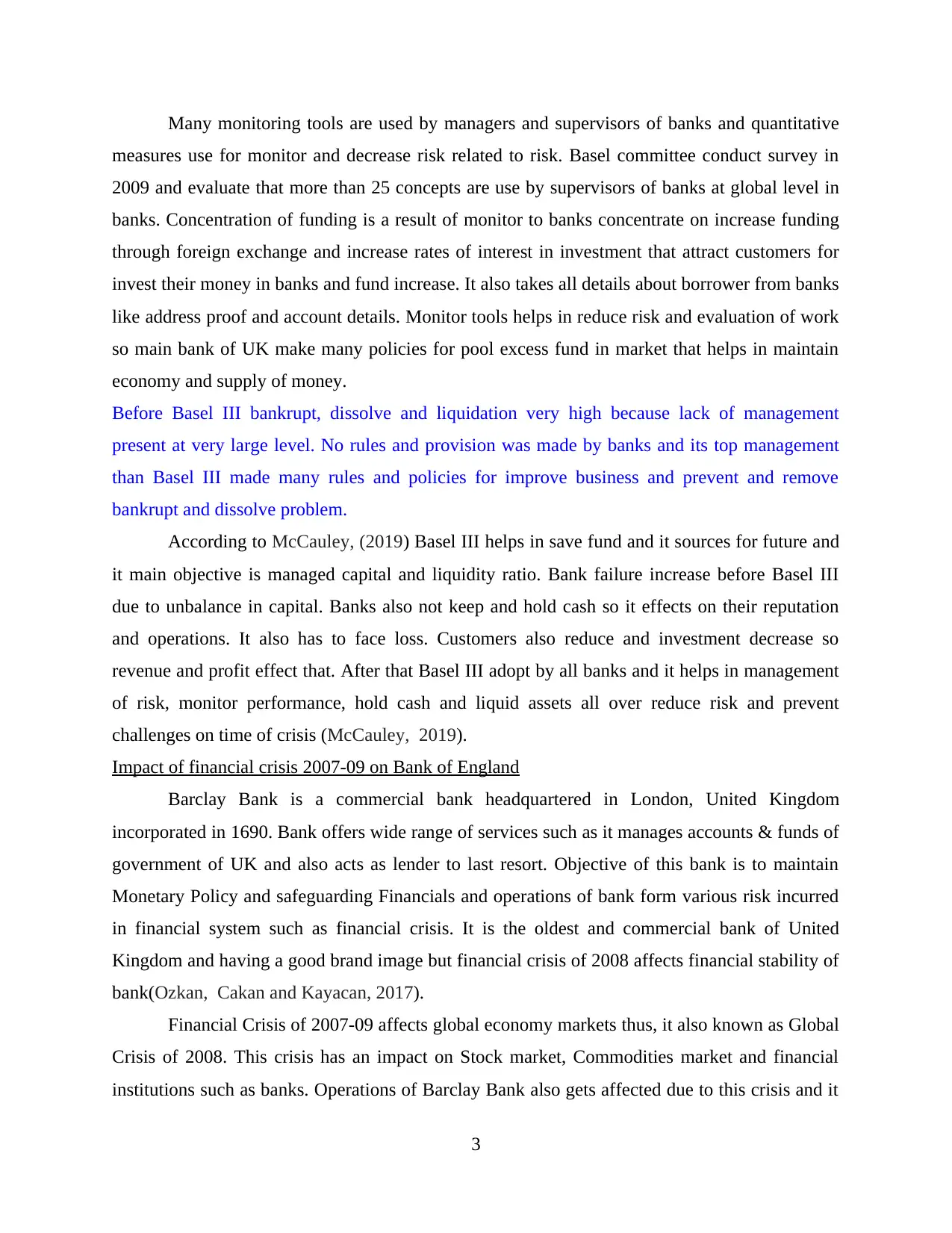
Many monitoring tools are used by managers and supervisors of banks and quantitative
measures use for monitor and decrease risk related to risk. Basel committee conduct survey in
2009 and evaluate that more than 25 concepts are use by supervisors of banks at global level in
banks. Concentration of funding is a result of monitor to banks concentrate on increase funding
through foreign exchange and increase rates of interest in investment that attract customers for
invest their money in banks and fund increase. It also takes all details about borrower from banks
like address proof and account details. Monitor tools helps in reduce risk and evaluation of work
so main bank of UK make many policies for pool excess fund in market that helps in maintain
economy and supply of money.
Before Basel III bankrupt, dissolve and liquidation very high because lack of management
present at very large level. No rules and provision was made by banks and its top management
than Basel III made many rules and policies for improve business and prevent and remove
bankrupt and dissolve problem.
According to McCauley, (2019) Basel III helps in save fund and it sources for future and
it main objective is managed capital and liquidity ratio. Bank failure increase before Basel III
due to unbalance in capital. Banks also not keep and hold cash so it effects on their reputation
and operations. It also has to face loss. Customers also reduce and investment decrease so
revenue and profit effect that. After that Basel III adopt by all banks and it helps in management
of risk, monitor performance, hold cash and liquid assets all over reduce risk and prevent
challenges on time of crisis (McCauley, 2019).
Impact of financial crisis 2007-09 on Bank of England
Barclay Bank is a commercial bank headquartered in London, United Kingdom
incorporated in 1690. Bank offers wide range of services such as it manages accounts & funds of
government of UK and also acts as lender to last resort. Objective of this bank is to maintain
Monetary Policy and safeguarding Financials and operations of bank form various risk incurred
in financial system such as financial crisis. It is the oldest and commercial bank of United
Kingdom and having a good brand image but financial crisis of 2008 affects financial stability of
bank(Ozkan, Cakan and Kayacan, 2017).
Financial Crisis of 2007-09 affects global economy markets thus, it also known as Global
Crisis of 2008. This crisis has an impact on Stock market, Commodities market and financial
institutions such as banks. Operations of Barclay Bank also gets affected due to this crisis and it
3
measures use for monitor and decrease risk related to risk. Basel committee conduct survey in
2009 and evaluate that more than 25 concepts are use by supervisors of banks at global level in
banks. Concentration of funding is a result of monitor to banks concentrate on increase funding
through foreign exchange and increase rates of interest in investment that attract customers for
invest their money in banks and fund increase. It also takes all details about borrower from banks
like address proof and account details. Monitor tools helps in reduce risk and evaluation of work
so main bank of UK make many policies for pool excess fund in market that helps in maintain
economy and supply of money.
Before Basel III bankrupt, dissolve and liquidation very high because lack of management
present at very large level. No rules and provision was made by banks and its top management
than Basel III made many rules and policies for improve business and prevent and remove
bankrupt and dissolve problem.
According to McCauley, (2019) Basel III helps in save fund and it sources for future and
it main objective is managed capital and liquidity ratio. Bank failure increase before Basel III
due to unbalance in capital. Banks also not keep and hold cash so it effects on their reputation
and operations. It also has to face loss. Customers also reduce and investment decrease so
revenue and profit effect that. After that Basel III adopt by all banks and it helps in management
of risk, monitor performance, hold cash and liquid assets all over reduce risk and prevent
challenges on time of crisis (McCauley, 2019).
Impact of financial crisis 2007-09 on Bank of England
Barclay Bank is a commercial bank headquartered in London, United Kingdom
incorporated in 1690. Bank offers wide range of services such as it manages accounts & funds of
government of UK and also acts as lender to last resort. Objective of this bank is to maintain
Monetary Policy and safeguarding Financials and operations of bank form various risk incurred
in financial system such as financial crisis. It is the oldest and commercial bank of United
Kingdom and having a good brand image but financial crisis of 2008 affects financial stability of
bank(Ozkan, Cakan and Kayacan, 2017).
Financial Crisis of 2007-09 affects global economy markets thus, it also known as Global
Crisis of 2008. This crisis has an impact on Stock market, Commodities market and financial
institutions such as banks. Operations of Barclay Bank also gets affected due to this crisis and it
3
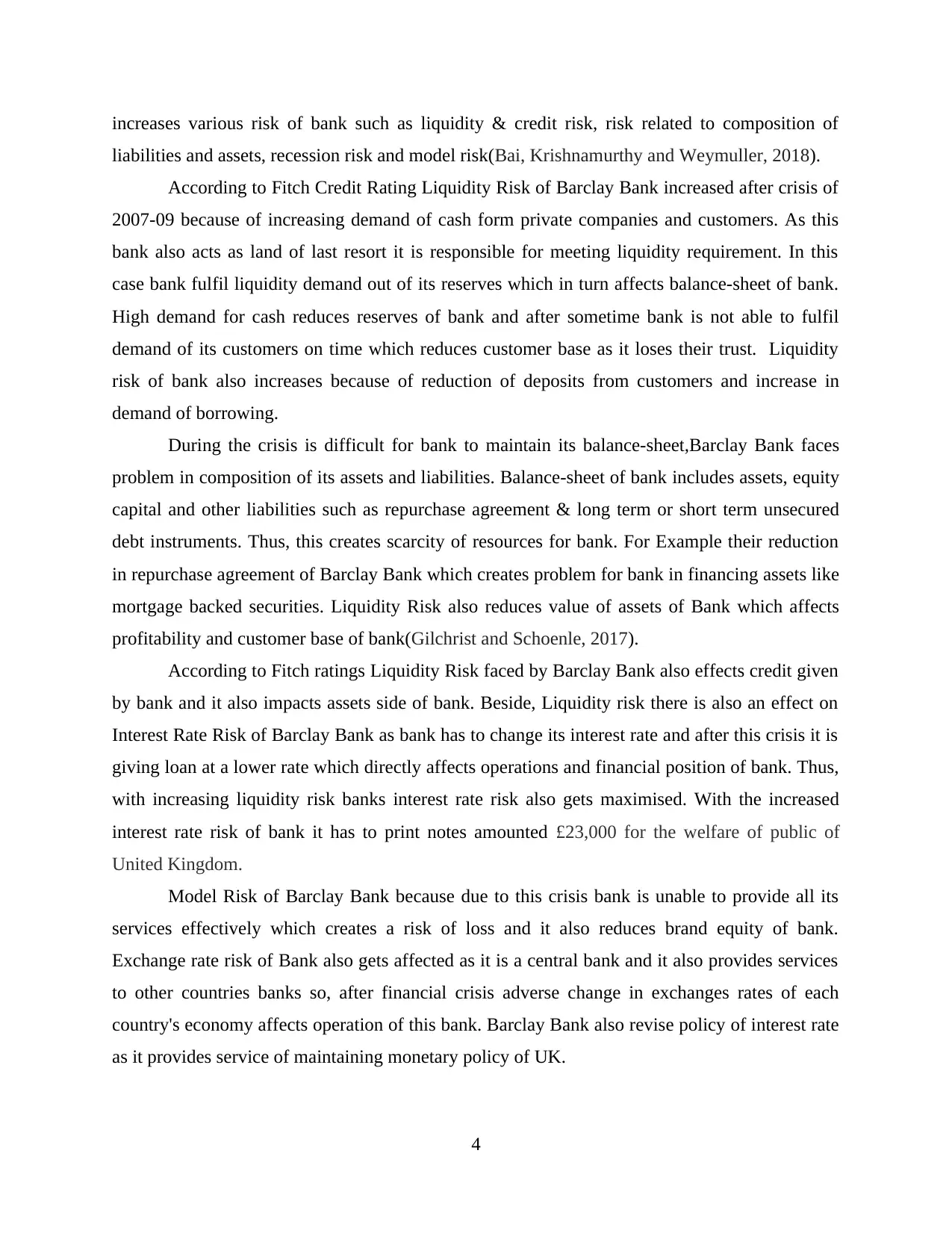
increases various risk of bank such as liquidity & credit risk, risk related to composition of
liabilities and assets, recession risk and model risk(Bai, Krishnamurthy and Weymuller, 2018).
According to Fitch Credit Rating Liquidity Risk of Barclay Bank increased after crisis of
2007-09 because of increasing demand of cash form private companies and customers. As this
bank also acts as land of last resort it is responsible for meeting liquidity requirement. In this
case bank fulfil liquidity demand out of its reserves which in turn affects balance-sheet of bank.
High demand for cash reduces reserves of bank and after sometime bank is not able to fulfil
demand of its customers on time which reduces customer base as it loses their trust. Liquidity
risk of bank also increases because of reduction of deposits from customers and increase in
demand of borrowing.
During the crisis is difficult for bank to maintain its balance-sheet,Barclay Bank faces
problem in composition of its assets and liabilities. Balance-sheet of bank includes assets, equity
capital and other liabilities such as repurchase agreement & long term or short term unsecured
debt instruments. Thus, this creates scarcity of resources for bank. For Example their reduction
in repurchase agreement of Barclay Bank which creates problem for bank in financing assets like
mortgage backed securities. Liquidity Risk also reduces value of assets of Bank which affects
profitability and customer base of bank(Gilchrist and Schoenle, 2017).
According to Fitch ratings Liquidity Risk faced by Barclay Bank also effects credit given
by bank and it also impacts assets side of bank. Beside, Liquidity risk there is also an effect on
Interest Rate Risk of Barclay Bank as bank has to change its interest rate and after this crisis it is
giving loan at a lower rate which directly affects operations and financial position of bank. Thus,
with increasing liquidity risk banks interest rate risk also gets maximised. With the increased
interest rate risk of bank it has to print notes amounted £23,000 for the welfare of public of
United Kingdom.
Model Risk of Barclay Bank because due to this crisis bank is unable to provide all its
services effectively which creates a risk of loss and it also reduces brand equity of bank.
Exchange rate risk of Bank also gets affected as it is a central bank and it also provides services
to other countries banks so, after financial crisis adverse change in exchanges rates of each
country's economy affects operation of this bank. Barclay Bank also revise policy of interest rate
as it provides service of maintaining monetary policy of UK.
4
liabilities and assets, recession risk and model risk(Bai, Krishnamurthy and Weymuller, 2018).
According to Fitch Credit Rating Liquidity Risk of Barclay Bank increased after crisis of
2007-09 because of increasing demand of cash form private companies and customers. As this
bank also acts as land of last resort it is responsible for meeting liquidity requirement. In this
case bank fulfil liquidity demand out of its reserves which in turn affects balance-sheet of bank.
High demand for cash reduces reserves of bank and after sometime bank is not able to fulfil
demand of its customers on time which reduces customer base as it loses their trust. Liquidity
risk of bank also increases because of reduction of deposits from customers and increase in
demand of borrowing.
During the crisis is difficult for bank to maintain its balance-sheet,Barclay Bank faces
problem in composition of its assets and liabilities. Balance-sheet of bank includes assets, equity
capital and other liabilities such as repurchase agreement & long term or short term unsecured
debt instruments. Thus, this creates scarcity of resources for bank. For Example their reduction
in repurchase agreement of Barclay Bank which creates problem for bank in financing assets like
mortgage backed securities. Liquidity Risk also reduces value of assets of Bank which affects
profitability and customer base of bank(Gilchrist and Schoenle, 2017).
According to Fitch ratings Liquidity Risk faced by Barclay Bank also effects credit given
by bank and it also impacts assets side of bank. Beside, Liquidity risk there is also an effect on
Interest Rate Risk of Barclay Bank as bank has to change its interest rate and after this crisis it is
giving loan at a lower rate which directly affects operations and financial position of bank. Thus,
with increasing liquidity risk banks interest rate risk also gets maximised. With the increased
interest rate risk of bank it has to print notes amounted £23,000 for the welfare of public of
United Kingdom.
Model Risk of Barclay Bank because due to this crisis bank is unable to provide all its
services effectively which creates a risk of loss and it also reduces brand equity of bank.
Exchange rate risk of Bank also gets affected as it is a central bank and it also provides services
to other countries banks so, after financial crisis adverse change in exchanges rates of each
country's economy affects operation of this bank. Barclay Bank also revise policy of interest rate
as it provides service of maintaining monetary policy of UK.
4
⊘ This is a preview!⊘
Do you want full access?
Subscribe today to unlock all pages.

Trusted by 1+ million students worldwide
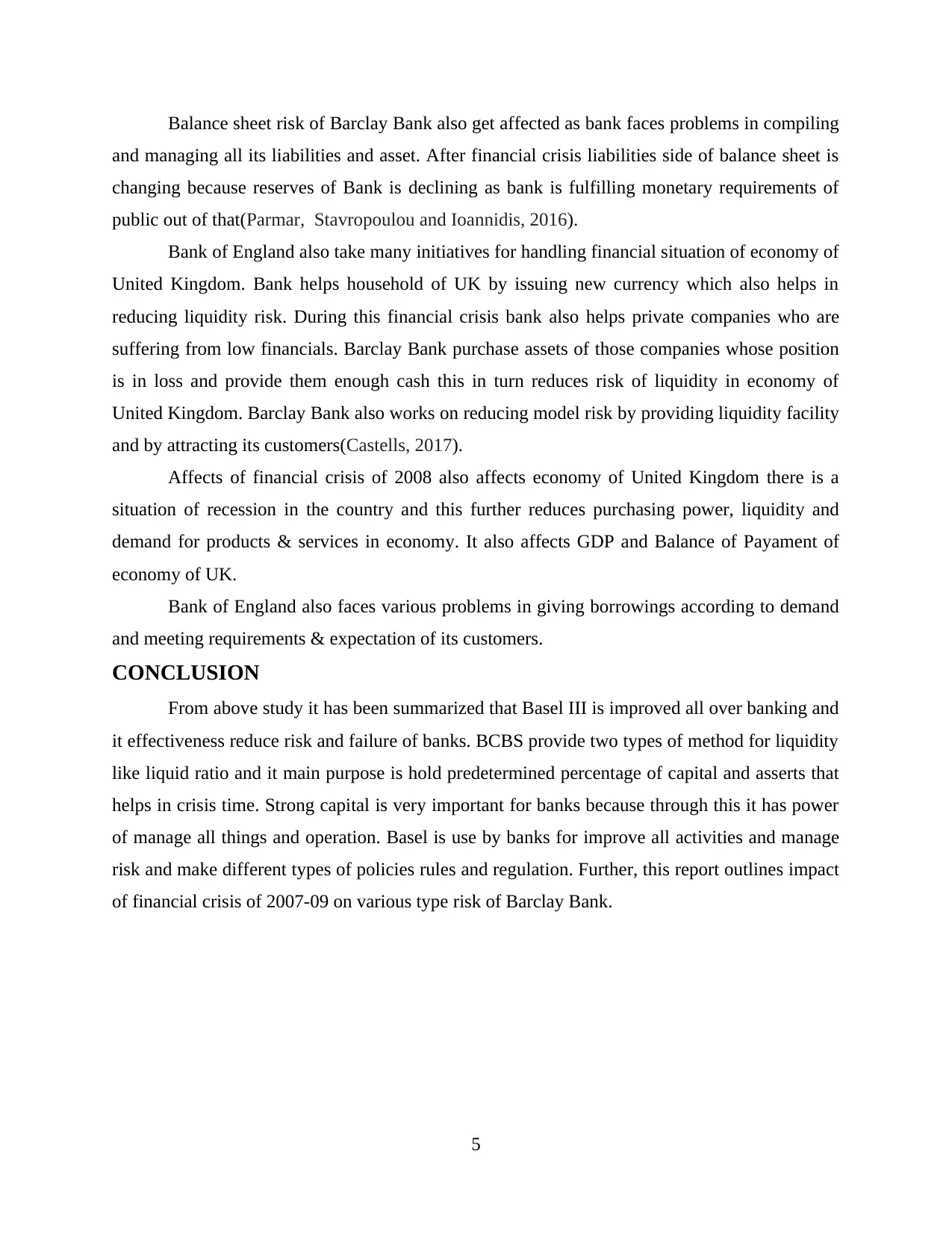
Balance sheet risk of Barclay Bank also get affected as bank faces problems in compiling
and managing all its liabilities and asset. After financial crisis liabilities side of balance sheet is
changing because reserves of Bank is declining as bank is fulfilling monetary requirements of
public out of that(Parmar, Stavropoulou and Ioannidis, 2016).
Bank of England also take many initiatives for handling financial situation of economy of
United Kingdom. Bank helps household of UK by issuing new currency which also helps in
reducing liquidity risk. During this financial crisis bank also helps private companies who are
suffering from low financials. Barclay Bank purchase assets of those companies whose position
is in loss and provide them enough cash this in turn reduces risk of liquidity in economy of
United Kingdom. Barclay Bank also works on reducing model risk by providing liquidity facility
and by attracting its customers(Castells, 2017).
Affects of financial crisis of 2008 also affects economy of United Kingdom there is a
situation of recession in the country and this further reduces purchasing power, liquidity and
demand for products & services in economy. It also affects GDP and Balance of Payament of
economy of UK.
Bank of England also faces various problems in giving borrowings according to demand
and meeting requirements & expectation of its customers.
CONCLUSION
From above study it has been summarized that Basel III is improved all over banking and
it effectiveness reduce risk and failure of banks. BCBS provide two types of method for liquidity
like liquid ratio and it main purpose is hold predetermined percentage of capital and asserts that
helps in crisis time. Strong capital is very important for banks because through this it has power
of manage all things and operation. Basel is use by banks for improve all activities and manage
risk and make different types of policies rules and regulation. Further, this report outlines impact
of financial crisis of 2007-09 on various type risk of Barclay Bank.
5
and managing all its liabilities and asset. After financial crisis liabilities side of balance sheet is
changing because reserves of Bank is declining as bank is fulfilling monetary requirements of
public out of that(Parmar, Stavropoulou and Ioannidis, 2016).
Bank of England also take many initiatives for handling financial situation of economy of
United Kingdom. Bank helps household of UK by issuing new currency which also helps in
reducing liquidity risk. During this financial crisis bank also helps private companies who are
suffering from low financials. Barclay Bank purchase assets of those companies whose position
is in loss and provide them enough cash this in turn reduces risk of liquidity in economy of
United Kingdom. Barclay Bank also works on reducing model risk by providing liquidity facility
and by attracting its customers(Castells, 2017).
Affects of financial crisis of 2008 also affects economy of United Kingdom there is a
situation of recession in the country and this further reduces purchasing power, liquidity and
demand for products & services in economy. It also affects GDP and Balance of Payament of
economy of UK.
Bank of England also faces various problems in giving borrowings according to demand
and meeting requirements & expectation of its customers.
CONCLUSION
From above study it has been summarized that Basel III is improved all over banking and
it effectiveness reduce risk and failure of banks. BCBS provide two types of method for liquidity
like liquid ratio and it main purpose is hold predetermined percentage of capital and asserts that
helps in crisis time. Strong capital is very important for banks because through this it has power
of manage all things and operation. Basel is use by banks for improve all activities and manage
risk and make different types of policies rules and regulation. Further, this report outlines impact
of financial crisis of 2007-09 on various type risk of Barclay Bank.
5
Paraphrase This Document
Need a fresh take? Get an instant paraphrase of this document with our AI Paraphraser

REFERENCES
Books and Journals
Castells, M., 2017. Another economy is possible: culture and economy in a time of crisis. John
Wiley & Sons.
Parmar, D., Stavropoulou, C. and Ioannidis, J.P., 2016. Health outcomes during the 2008
financial crisis in Europe: systematic literature review. Bmj. 354. p.i4588.
Gilchrist, S. and Schoenle, R., 2017. Inflation dynamics during the financial crisis. American
Economic Review. 107(3). pp.785-823.
Bai, J., Krishnamurthy, A. and Weymuller, C.H., 2018. Measuring liquidity mismatch in the
banking sector. The Journal of Finance. 73(1). pp.51-93.
Ozkan, N., Cakan, S. and Kayacan, M., 2017. Intellectual capital and financial performance: A
study of the Turkish Banking Sector. Borsa Istanbul Review. 17(3). pp.190-198.
Ingham, G., Coutts, K. and Konzelmann, S. 2016. Introduction:‘cranks’ and ‘brave heretics’:
rethinking money and banking after the Great Financial Crisis.
Turner, J.D. 2018. Money and Central Banking. In An Economist’s Guide to Economic
History (pp. 63-70). Palgrave Macmillan, Cham.
Tasca, P. And et.al., 2016. Banking beyond banks and money. AG, Switzerland: Springer
International Publishing.
McCauley, R.N. And et.al., 2019. Financial deglobalisation in banking?. Journal of
International Money and Finance. 94. pp.116-131.
Online
6
Books and Journals
Castells, M., 2017. Another economy is possible: culture and economy in a time of crisis. John
Wiley & Sons.
Parmar, D., Stavropoulou, C. and Ioannidis, J.P., 2016. Health outcomes during the 2008
financial crisis in Europe: systematic literature review. Bmj. 354. p.i4588.
Gilchrist, S. and Schoenle, R., 2017. Inflation dynamics during the financial crisis. American
Economic Review. 107(3). pp.785-823.
Bai, J., Krishnamurthy, A. and Weymuller, C.H., 2018. Measuring liquidity mismatch in the
banking sector. The Journal of Finance. 73(1). pp.51-93.
Ozkan, N., Cakan, S. and Kayacan, M., 2017. Intellectual capital and financial performance: A
study of the Turkish Banking Sector. Borsa Istanbul Review. 17(3). pp.190-198.
Ingham, G., Coutts, K. and Konzelmann, S. 2016. Introduction:‘cranks’ and ‘brave heretics’:
rethinking money and banking after the Great Financial Crisis.
Turner, J.D. 2018. Money and Central Banking. In An Economist’s Guide to Economic
History (pp. 63-70). Palgrave Macmillan, Cham.
Tasca, P. And et.al., 2016. Banking beyond banks and money. AG, Switzerland: Springer
International Publishing.
McCauley, R.N. And et.al., 2019. Financial deglobalisation in banking?. Journal of
International Money and Finance. 94. pp.116-131.
Online
6
1 out of 8
Related Documents
Your All-in-One AI-Powered Toolkit for Academic Success.
+13062052269
info@desklib.com
Available 24*7 on WhatsApp / Email
![[object Object]](/_next/static/media/star-bottom.7253800d.svg)
Unlock your academic potential
Copyright © 2020–2025 A2Z Services. All Rights Reserved. Developed and managed by ZUCOL.




